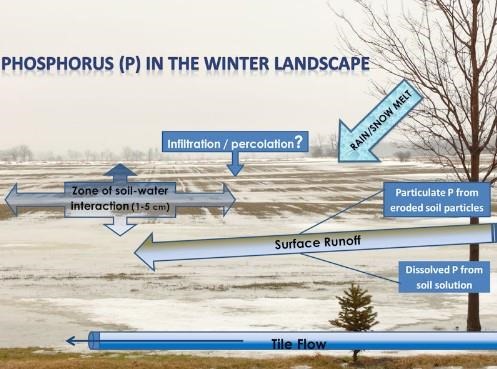BMP’s suggest that seed placed fertilizer, residue management and cover crops will help prevent soil phosphorus from reaching water courses. Manure application requires extra attention to prevent phosphorus losses, especially during winter and snow melt conditions.
Phosphorus (P) is essential to plant growth. Crop root growth is most prolific in soils enriched with phosphorus, but too much of a good thing can have negative environmental impacts. When phosphorus enters a water course, eutrophication results. Eutrophication is when a body of water becomes enriched in dissolved nutrients that stimulate the growth of aquatic plants. This can lead to fluctuations in dissolved oxygen, which limits aquatic life. Sometimes phosphorus in bodies of water can lead to toxic algae blooms.
Crop production practices focus on seed-placed P to maximize nutrient efficiency. Management practices that leave 30 percent or more soil cover – crop residue or growing crops – helps to keep soil P in place. The highest risk for soil P loss from crop land results from intense storms and from rainfall during snowmelt.

Figure 1: Phosphorus in the Winter Landscape
Every winter season is different and there are wide range of winter conditions across the province. Research studying the fate of nutrients has resulted in more measurements during the winter and snow melt seasons. Nutrient movement from soils in winter is often higher than all the other times of the year combined. Figure 1: Phosphorus in the Winter Landscape, shows the potential fate of P when exposed to melting snow combined with rain and frozen or partially frozen soils. Water can’t infiltrate or percolate a frozen soil, which results in overland flow. Under these conditions, the soil within the top 5 cm (2 inches) is unfrozen and saturated (mud) and can move easily with water as sheet or rill erosion. Phosphorus in this layer can dissolve into the soil solution and leave the field as dissolved P. When soil phosphorus levels are high, the risk of dissolved P (also known as soluble P) loss from the field is increased.
Where Does Manure Fit In This Picture?
In the winter landscape shown in Figure 1, an application of manure after crop harvest results in a higher amount of phosphorus in the root zone. When manure is surface applied and not incorporated, the phosphorus is concentrated in the top few cm of the soil. The higher the amount of P, the greater the risk of soluble P loss during winter runoff conditions. Where fall applied manure has been incorporated, the risk of soluble P loss is reduced. However incorporation can increase the risk of P loss in sediment (erosion).
Livestock manure and other organic amendments provide many crop nutrients to the soil. Management, therefore, must consider the bigger picture instead of only focusing on one nutrient. Both nitrogen (N) and P loss can lead to negative impact on the environment and management for one nutrient can increase the loss of the other.
No-till practices help to keep crop residue on the surface to reduce soil erosion. However manure applied to no-till soil in the fall is generally not incorporated, resulting in some of the nitrogen being compromised. On the other hand, colder soil temperatures slow down soil microbial activity, which reduces risk of volatilization loss. It also reduces leaching losses of N when manure is applied in late fall or injected/incorporated during the winter months. Although the risk of N loss is reduced, the risk of P loss is increased with the concentrated P levels near the soil surface.
Practices That Reduce Risk of P Loss From Manure:
- Avoid winter application! Even if the nutrients don’t move to the water course, the nutrients most often don’t remain where they were applied.
- Avoid nutrient application in areas of concentrated flow, or pathways where water flows during heavy rainfalls and/or snowmelt
- Calibrate equipment for accurate rate and uniformity of application
- Growing crops make the most efficient use of nutrients. Apply as close to crop needs as possible.
- Apply manure at rates that meet crop needs
- Apply manure to fields that have relatively low P fertility levels first.
- Incorporate manure - ideally leave greater than 30% residue cover
- Plant cover crops to help keep soil covered and hold nutrients.
Source: OSCIA